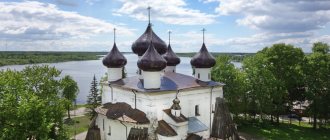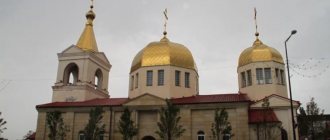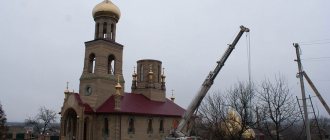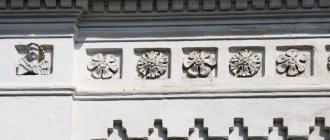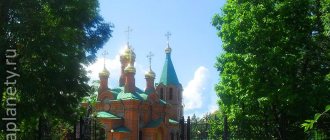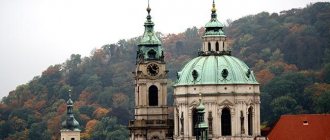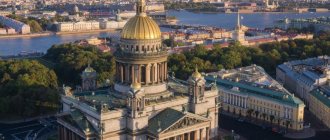Orthodox church. Style, forms, symbolism
“The idea of Christianity is unchanged, but the forms of temples are changeable”
N.V. Pokrovsky
This article will attempt to answer the questions:
- Is there a documented regulation (or church architectural canon) for the construction of Orthodox churches, legitimized by the church authorities and the state, and what is it?
- Are all Orthodox churches in different countries designed in the same style or do they differ in appearance from each other?
Until recently, I lived with the idea that Orthodox churches are built according to certain rules. That is, I thought that there was an established tradition that should be followed when building Orthodox churches, enshrined in normative documents, most likely issued by the church itself.
Closing my eyes and conjuring up the image of an Orthodox church, I most often saw it with golden domes that ended with crosses; there was always a church bell present. The colors of the temple - they seemed to me mostly white, with the addition of blue or light blue and gold. This is exactly what they look like in our city. The first time I performed the sacrament of confession and communion (an unforgettable and incomparable feeling) was at the Ksenia Intercession Monastery in the village of Mikhailovka (Yarovoye, Altai Territory) - it looked the same. If you think about it and strain your memory, then when traveling around Russia you can remember the painting of the outer walls in different colors, and the log churches that you saw with your own eyes or in pictures.
A feature of Orthodoxy that has influenced the architecture of churches in different countries is that the Orthodox Church includes several independent Churches. In addition to the Russian Orthodox Church, there are Georgian, Serbian, Greek, Romanian and others. These Churches are governed by patriarchs, archbishops and metropolitans. Not all Orthodox churches have communion with each other in sacraments and prayers (which, according to the catechism of Metropolitan Philaret, is a necessary condition for individual Churches to be part of the one Universal Church). Also, not all Orthodox churches recognize each other as true churches. The Orthodox consider Jesus Christ to be the head of the church. There is no administrative body of the entire Orthodox Church.
Territorial division, isolation and ethnic identity also affected the appearance of churches in various Orthodox countries. Look at examples from different countries where Orthodoxy is the leading religion.
Georgia
The coolest one - known to every resident of Georgia, and the most famous in the world - is the Svetitskhoveli Cathedral. The first king of Georgia was baptized in it. The tradition of the Georgian Church has preserved the memory of the presence here of the greatest shrine of the Christian world - the Tunic of our Lord Jesus Christ.
The Church of St. Nicholas is located in the very center of Batumi. This church is more than 150 years old and is one of the oldest in Batumi.
Cathedral of the Blessed Virgin Mary . Started in 1897 and completed in 1902.
After the annexation of Batumi to Russia, the influx of Catholics into the city increased. Among the parishioners of the churches were Georgians, foreign subjects - French, Poles, engaged in trade and handicrafts. Subjects of a number of European states turned to their consuls with a request to open their Catholic church in Batumi. The church was designed and built in the neo-Gothic style. The top of the cathedral is decorated with three domes. By all standards of Gothic buildings, the façade of the temple is decorated with ornaments. And in 1989, it was solemnly transferred to the possession of Orthodox ministers. Today the Cathedral of the Blessed Virgin Mary is the main church of the local diocese.
Romania
The Church of St. Nicholas is a Romanian Orthodox church in Brasov, in the historical district of Shkei. They began to build in 1200-1300. The construction was completed in 1495, local residents rebuilt the church in stone with the support of the son of Vlad Dracula. Well, then they rebuilt it. In the 18th century, thanks to donations from the Russian Empress Elizabeth Petrovna, a clock tower, as well as a chapel and a vestibule, were added to the church. Empress Catherine II of Russia sent expensive gifts to the Church of St. Nicholas - gold and silver religious objects, icons, church books, money. Originally built in the Gothic style, the church was later rebuilt in the Baroque style.
And another tiny Orthodox Church of Romania, St. Paraskeva-Pyatnitsa, in the local cemetery, is interesting with turrets like those of Muslim mosques.
Serbia
1 The Church of St. Sava is one of the largest Orthodox churches in the world. However, in its layout, the Temple of St. Sava differs from the Constantinople model - the St. Sophia Cathedral. An element of the Serbian medieval style is the addition of four turrets around the main dome.
Now - as for Mother Russia.
Log churches are most often tented churches. (There were also cages and tiered ones) Tent architecture of the 16th-17th centuries, which draws its origins from traditional Russian wooden architecture, is a unique direction of Russian architecture, which has no analogues in the art of other countries and peoples.
The tented temple is characterized by the fact that an octagonal one (octagon) is placed on a quadrangular frame (chetverik). As can be seen in the diagram and photo of the tented churches (in the diagram from left to right - the cage church, the tented one and the tiered one).
Church of Alexander Nevsky in Arkhangelsk
In the 17th century, Patriarch Nikon, who first began to draw up drawings of churches, banned the construction of tented churches, and ordered the construction of five-domed churches (M. Pokrovsky “Monuments of Christian architecture, especially Russian”).
And now the buildings of all Orthodox churches are always crowned with domes, which symbolize the spiritual sky. The domes are topped with crosses. The different number of domes, or chapters, of a temple building is determined by who they are dedicated to.
Let's return to the question - the Orthodox architectural canon (rule) - does it exist and what is it?
He's gone. I did not find it published on paper or any other medium. But there is a so-called Theological understanding of the canon - that is, symbolism - as an applied language for expressing a religious idea. Priest B. Mikhailov in his article “Criteria of Churchness in Temple Architecture” writes that “We live in a peculiar time: an artificial break in temple construction has led to the loss of skills and continuity and a sense of living tradition. Therefore, we are now in search of churchliness, we are collectively defining it.” As examples of Orthodox architecture, he gives the example of a courtyard in the Optina Desert in the Trinity Church in Ostankino, the Church of St. Nicholas in Klepniki and so on. The result of his article is expressed in the following phrase: “If temple architecture in its own language and by its own means pronounces this living word about God, it is ecclesiastical.”
The illustration below shows the traditional layout of an Orthodox church and the Trinity Church in Ostankino as an example of Orthodox architecture recognized by the church.
Well, it is clear that in a situation where there are no church norms, the most decisive role in the creation and approval of the external face of the Orthodox Church is played by the human factor. On the one hand, this is the personality of the artist creating the sketch or project. His theological understanding, his beauty, his understanding of God, his techniques and methods. Well, on the opposite side, this is the Orthodox Diocese of the administrative-territorial unit where this temple is going to be built. That is, the church authority approves the project and gives it further life. And then, there are government bodies.
A striking example of this. March 1837. Metropolitan Philaret, canonized, gives a plan for the construction of a temple in Moscow in the name of Christ the Savior, “with completely new meanings, based on the symbols of the vision of St. John the Evangelist". According to him, this project was inspired in him from above.
Three sections, as usual - the meal, the church itself, and the altar. Seven thrones - according to the number of seven churches - two thrones in the meal, five in the church (dedicated to the Annunciation, Nativity, Epiphany, Transfiguration, Resurrection). At the top of the temple, symbolizing the throne of the Most High, is the all-seeing eye. Instead of windows there are seven slits with glass - the likeness of seven lamps before the Lord. In the upper part there are four arcs of seven-color glass depicting a rainbow - a symbol of the reconciliation of God with man.
Based on Holy Scripture, emanating from one of the first hierarchs of the Orthodox Church, the project was ignored due to its “unchurchishness.”
What remains unchanged throughout the history of Orthodoxy in the language of temple construction?
- The layout is a three-part structure - a vestibule, a temple and an altar, or a two-part structure - a temple and an altar. This is a symbol of the Trinity.
- The number of chapters is necessarily symbolic. One large chapter is surrounded by twelve - according to the number of Jesus' disciples. One-headed - Unity of the Savior. Five-headed - forming through this symbol of Christ surrounded by four evangelists.
- The orientation of the temple altar to the East (a deviation of 15 degrees is allowed) is an indispensable condition for the construction of an Orthodox church. Symbolizes the cardinal direction of the lost paradise.
But on the part of the state there is a standard regulating the construction of an Orthodox church. A document has been published in Russia - Code of Rules for the design and construction of joint ventures - 31-103-99. Buildings, structures and complexes of Orthodox churches. This code brings together and mixes all the existing requirements of urban planning plans and church traditions.
It summarizes and systematizes, most likely, together with church representatives, data on church construction. Definitions are given of the parts of the temple, its appearance, planning type and its symbolic elements.
Here we will also find three parts.
And we will see examples of church planning types recognized by the church in the right diagram. Figure 1, 2,3 - cubic type, 4 and 5 - centric type, 6 - cross-dome. There is another type of temple layout, called a “ship” - it is rectangular, but for some reason it was not included in this collection, although it is recognized by the church and is often found in other literature.
In general, there is rather modest information about the architectural canons of Orthodoxy, and the norms themselves found in special literature are also few in number. That is, in Orthodoxy, the architectural canon is expressed in the symbolism of the temple, which in turn is subordinated to the very idea of Orthodoxy and the purpose of the temple - as a place for worship and prayer. Well, we can also conclude that temple buildings built in a certain tradition, over time, become this very architectural canon - that is, they are cited as an example. Well, that's probably all, my friends. 
The temple is an image of the presence of the Kingdom of Heaven on earth, and accordingly it is an image of the palace of the King of Heaven. From this image comes the tradition of decorating the temple like royal palaces, using all the artistic means available to a particular era.
The temple is also an image of the universal Church, its basic principles and structure. In the "Creed" the Church is called "One, Holy, Catholic and Apostolic." In some way, these features of the Church can be reflected in temple architecture. For example, the image of the unity of the Church headed by Christ is visibly embodied by the single-domed cubic volumes of ancient Russian churches. The holiness of the Church is figuratively expressed by the whiteness of the walls of churches and the radiance of golden domes, like halos on icons of saints. Conciliarity and apostolic succession are expressed, as in the hierarchical structure of the Church itself, by the centricity of the composition, the hierarchical ordering of the parts of the temple, subordinate to the central under-dome space.
In patristic interpretations, the temple is also likened to the image of God. Thus, the triune structure of the temple corresponds to the trinity of God; the otherworldliness of God and the Church is expressed in the forms of the temple, which are different from the forms of residential and other structures for earthly purposes.
The incomprehensible God reveals Himself in the world in such names that are reflected in the architecture of the temple. Thus, God is referred to as Beauty, Love, Unity, Light, Truth, Good. In temple architecture, these names are expressed in the proportional correspondence of the whole and parts, symmetry of composition, integrity of form, clarity of composition, tectonicity of the structure, recognition of form.
The interior of the cross-domed church is an integral system of hierarchically ordered spaces, developing from the side naves, where the main part of the worshipers are located, to the central under-dome space with the pulpit in the center and further upward, to the dome, on which there is a light-filled image of the Head of the Church - Christ Pantocrator . Such a harmonious spatial system clearly represents the symbolic essence of the temple as the beginning of the future Kingdom of God.
A schematic model of an Orthodox church with the symbolic meaning of its elements is shown in Fig. 5.
In terms of planning, the altar shows the image of Paradise, the spiritual world descending to earth to people. The middle part of the temple is a symbol of heaven and earth, the universe, renewed by reconciliation with the spiritual world. The porch is a symbol of the unjustified, sinful world.
In the middle part of the temple stand the faithful, who, upon receiving the divine Grace poured out in the Sacraments, become redeemed, sanctified, partakers of the Kingdom of God. If the altar contains the divine principle, then in the middle part of the temple there is the human principle, which enters into the closest communion with God. And if the altar received the meaning of the supreme sky “heaven of heaven,” where only God dwells with the heavenly ranks, then the middle part of the temple means a particle of the future renewed world, a new heaven and a new earth in the proper sense.
The altar in the temple means the spiritual, divine side in the universe, and its middle part - the sensory world, and both enter into interaction in which the first enlightens and guides the second. With this attitude, the order of the universe, disrupted by sin, is restored.
Various areas of the middle part of the temple also receive interpretation from the Holy Fathers. Thus, the upper zone means the visible sky, and the lamps depict stars, and the chandeliers represent the circles of the planets. The lower zone means earth.
The iconostasis, separating the altar from the middle part of the temple, expresses the idea of the closest and inextricable connection that exists between the sensory and spiritual worlds through the prayerful help of the celestial beings depicted there in the icons, including those who have already achieved a state of holiness on earth, that is, deification, to which others only strive.
The Old Russian temple ends with a head of “onion” shape. If the flat Byzantine dome above the temple resembles the vault of heaven above the earth, and the Gothic spire of Catholic churches expresses the desire upward, to heaven, then the Russian onion dome resembles a fiery tongue, symbolizing the idea of the prayerful burning necessary for every Christian to unite with God.
